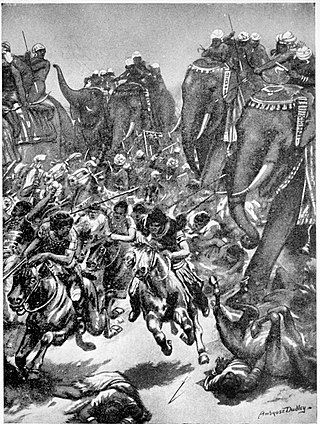Top Qs
Timeline
Chat
Perspective
Battle of Sondani
528 battle From Wikipedia, the free encyclopedia
Remove ads
The Battle of Sondani was a large military encounter fought in 528 CE, between the Alchon Hun king Mihirakula and a confederation of Indian rulers led by King Yashodharman of Malwa and King Narasimhagupta of the Gupta Empire.
Remove ads
Background
The Alchon Huns under their able leader Toramana invaded the mainland of the Indian subcontinent. The Huns extensively weakened the Gupta Empire by their devastating raids. Toramana was finally vanquished with certainty by an Indian king of the Aulikaras of Malwa, after nearly 20 years in India. According to the Rīsthal stone-slab inscription, discovered in 1983, King Prakashadharma defeated Toramana in 515 CE.[5][6][7] The First Hunnic War thus ended with a Hunnic defeat, and their troops apparently retreated to the area of Mahasaptsindhu.[5]
Mihirakula, the eldest son and successor of Toramana, again invaded India. He was even crueler and caused more destruction than his predecessor. Yashodharman, the ruler of Malwa and the son of King Prakashadharma, created an alliance with the other Indian rulers to defeat the Huns.[citation needed]
Remove ads
Result
Summarize
Perspective
A confederacy of Indian rulers led by Yashodharman, and possibly even supported by the Gupta King Narasimhagupta, decisively defeated the Hunnic armies at Sondani in 528 CE. [citation needed]
This resulted in the loss of Alchon possessions in the Punjab and north India by 542. The Sondani inscription in Sondani, near Mandsaur, records the submission by the Hunas, and claims that Yasodharman had rescued the earth from rude and cruel kings,[8][Note 1] and that he "had bent the head of Mihirakula".[5] In a part of the Sondani inscription Yasodharman thus praises himself for having defeated king Mihirakula:[9]
He (Yasodharman) to whose two feet respect was paid, with complimentary presents of the flowers from the lock of hair on the top of (his) head, by even that (famous) king Mihirakula, whose forehead was pained through being bent low down by the strength of (his) arm in (the act of compelling) obeisance
The Gupta King Narasimhagupta is also credited in helping repulse Mihirakula, after the latter had conquered most of India, according to the reports of Chinese monk Xuanzang.[11][12]
In a fanciful account, Xuanzang, who wrote a century later in 630 CE, reported that Mihirakula had conquered all India except for an island where the King of Magadha named Baladitya (who could be Gupta ruler Narasimhagupta Baladitya) took refuge, but that was finally captured by the Indian king. He later spared Mihirakula's life on the intercession of his mother, as she perceived the Hun ruler "as a man of remarkable beauty and vast wisdom".[12] Mihirakula is then said to have returned to Kashmir to retake the throne.[13][14]: 168

Remove ads
Aftermath
After the war was over, Yashodharman conquered vast territories and established a short-lived empire.[citation needed]
In the Mandsaur pillar inscription, Yashodharman claims he vanquished his enemies and now controls the territory from the neighbourhood of the (river) Lauhitya (Brahmaputra River) to the "Western Ocean" (Western Indian Ocean), and from the Himalayas to mountain Mahendra.[15][16]
Yashodharman thus conquered vast territories from the Hunas and the Guptas,[17] although his short-lived empire would ultimately disintegrate between c. 530-540 CE.[16]
See also
References
Wikiwand - on
Seamless Wikipedia browsing. On steroids.
Remove ads

